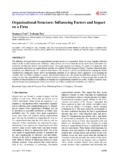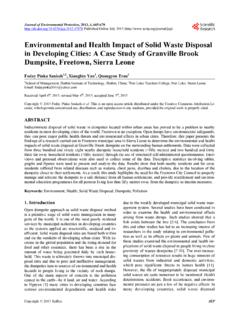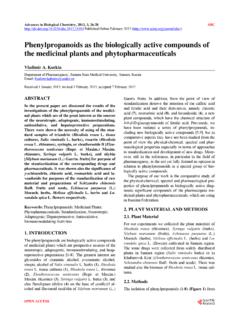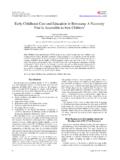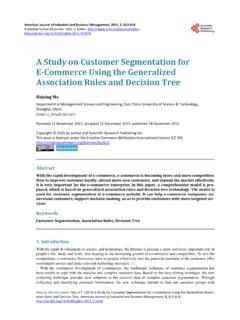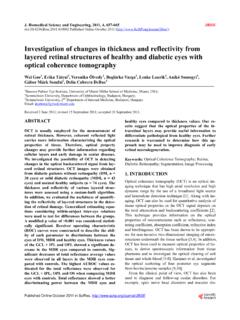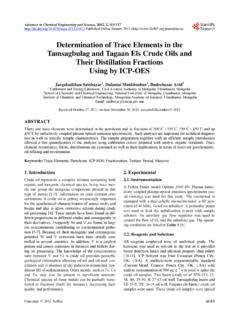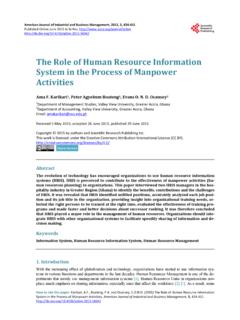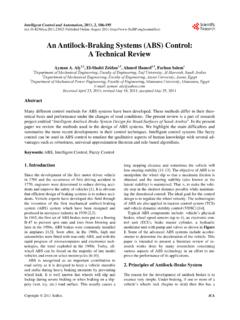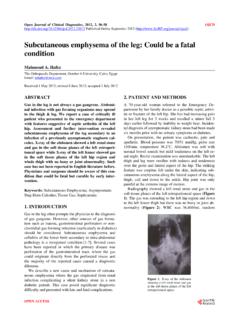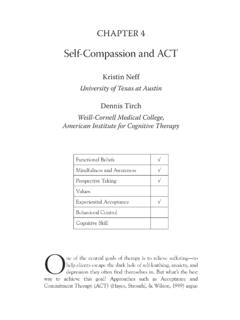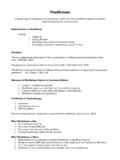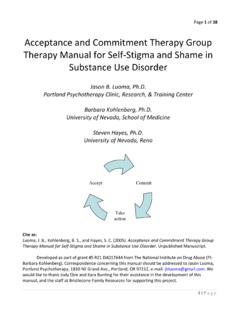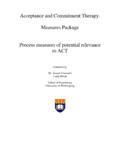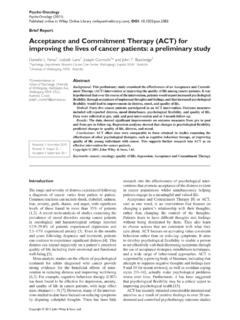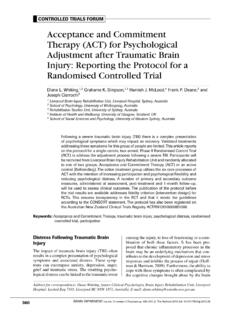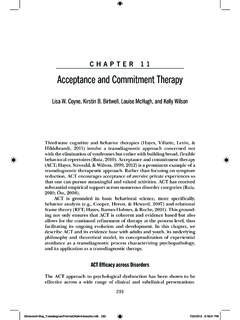Transcription of Acceptance & Commitment Therapy: An Overview …
1 Journal of Service Science and Management, 2014, 7, 216-221 Published Online June 2014 in SciRes. How to cite this paper: Larmar, S., Wiatrowski, S. and Lewis-Driver, S. (2014) Acceptance & Commitment therapy : An Overview of Techniques and Applications. Journal of Service Science and Management, 7, 216-221. Acceptance & Commitment therapy : An Overview of Techniques and Applications Stephen Larmar, Stanislaw Wiatrowski, Stephen Lewis-Driver Griffith School of Human Services and Social Work, Griffith University, Brisbane, Australia Email: Received 2 March 2014; revised 1 April 2014; accepted 25 April 2014 Copyright 2014 by authors and Scientific Research Publishing Inc. This work is licensed under the Creative Commons Attribution International License (CC BY). Abstract Acceptance and Commitment therapy (ACT) has emerged over the last twenty years within the context of the Third Wave of Cognitive Therapies, and has been utilised with reported success in a range of therapeutic and mental health settings.
2 Social and self-stigma related to seeking assis- tance for mental health and other concerns has been shown to reduce client engagement with therapeutic support. Numerous studies have been undertaken that support ACT as an empirically validated framework for engaging stigmatised client groups. This paper provides a review of the key philosophical underpinnings and prominent techniques employed in ACT. Further, the paper highlights the utility of ACT in treating mental illness and other conditions by encouraging thera- peutic participation through a use of techniques that inherently reduce the self and social stigma related to psychological disturbance and disability. Keywords Acceptance and Commitment therapy , Stigma, Mental Health, Therapeutic Engagement 1. Introduction While the primary intent of counselling and psychotherapeutic interventions is to provide psychosocial support, the potential stigmatising effects of accessing such support, especially for those suffering from mental health concerns, may prohibit engagement [1]-[4].
3 The consequences of stigmatisation may include delays in therapeu- tic outcomes [5], exiting therapy prematurely [6] or choosing not to access treatment [7]. Given the impact of potentially stigmatising attitudes towards counselling, greater consideration is necessary for the facilitation of therapeutic approaches that minimise the effects of stigmatisation and promote widening participation and so- cially inclusive therapeutic practices. This paper provides an Overview of ACT and posits that the underlying philosophy and techniques inherent in the process serve to redress potentially stigmatising effects encountered in S. Larmar et al. 217 alternative forms of therapy , thus rendering the ACT approach as a cogent framework to accommodate a di- verse population of individuals experiencing mental health concerns. 2. Acceptance and Commitment therapy : An Overview Developed by Hayes [8] in the late 1980 s, ACT emerged from behaviourist approaches to therapy .
4 Behaviour therapy is conceptualized within three corresponding categories or generations that include: behaviour therapy ; cognitive behavioural therapy (CBT) and the third generation or third wave of behaviour therapy [9] [10]. ACT is grounded in behaviourism, but is underpinned by analysis of cognitive processes [11]. In light of in- creasing empirical evidence, attempts have been made to classify ACT in its own right as a distinct, unified model of behaviour change linked to contextual behavioural science [12]. This third wave of behaviourism supports openness and Acceptance of psychological events, including those that are traditionally perceived to be negative or irrational [13]. The chief purpose of ACT is to encourage individuals to respond to situations con- structively, while simultaneously negotiating and accepting challenging cognitive events and corresponding feelings, rather than replacing them.
5 A key feature of ACT is the emphasis on the notion that behaviours and emotions can exist simultaneously and independently. ACT encourages the individual to accept and integrate into their lived experiences challenging affective responses and to recognise and eliminate the controlling di- mensions that specific contextual situations exert upon them [9]. ACT is underpinned by functional contextualism [14], a pragmatic philosophical position that recognises that psychological events (encompassing cognition, affective responses and behaviour) are influenced by antecedents within a specific context [15]. According to Hayes [13] the .. core components of functional contextualism are a) focus on the whole event, b) sensitivity to the role of context in understanding the nature and function of an event, c) emphasis on a pragmatic truth criterion, and d) specific scientific goals against which to apply the truth criterion.
6 A reductionist approach to therapy that focuses solely on the analysis of dysfunctional behaviour, rather than placing common behavioural responses within an historical and contextual position is rejected in ACT [13]. The approach utilises relational frame theory (RFT), a behaviour analytic theory of human behaviour that serves to explain the complex interplay of thought processes with behaviours [16] [17]. RFT provides a conceptual framework for understanding .. the learned ability to arbitrarily relate events, mutually and in combination, and to change the functions of events based on these relations [18]. According to RFT maladaptive processes occur as a result of the individual avoiding private events (cognitive processes and affective responses) based on their negative appraisal of these events. As the individual engages in ACT they learn to integrate these pri- vate events, consolidate personal values and adopt new ways of behaving [19].
7 A key assumption of ACT is that psychological processes in most individuals have the potential to be destruc- tive, in contrast to the predominant Western view that fundamentally, humans are psychologically healthy be- ings [9]. Unlike cognitive-behavioural approaches that reinforce the dynamic interplay between cognition, beha- viour and affect and the focus on replacing maladaptive thought processes with healthier cognitions, ACT teaches individuals to just notice , accept and embrace private experiences and focus on behavioural responses that produce more desirable outcomes [20]. Through this process the individual is encouraged to exercise in- creased psychological flexibility, drawing on personal values that lead to meaningful action [21]. The acronym FEAR is sometimes utilised in ACT to highlight key variables associated with psychological disequilibrium: Fusion of thoughts; Evaluation of experience; Avoidance of experience; and Reason-giving for behaviour [22].
8 Inherent in the practice of ACT are a number of mindfulness skills that include: Acceptance of thoughts and emotions; Cognitive defusion which involves developing accurate awareness of thoughts and emotions; Awareness of the moment by being open and receptive; and Observation of self [9]. By focusing upon accepting and integrating private events rather than extinguishing maladaptive thought patterns, these ACT techniques affectively reduce the self-stigma that often acts as a barrier to client engage- ment with therapy [4] [23]. 3. Therapeutic Techniques Common to ACT ACT approaches to therapy serve to counteract the negative effects of avoiding affective content, the influence S. Larmar et al. 218 of dogmatic literal responses to presenting cognitive themes and failure to commit to changes in behaviour [24] [25]. Like cognitive-behavioural therapy the process assists in the facilitation of changes in the individual s in- ternal dialogue or self-talk and their verbal behaviour.
9 The therapist encourages the individual to embrace their feelings, given that denying or struggling with negative affective responses can be counterproductive to psycho- logical health [26]. Initially, the therapist assists the individual to clarify challenges in the individual s world that they can overcome and those that they need to accept as an ongoing part of their lived experience. According to Hayes [13] seven core processes are inherent in the practice of ACT. These include: 1) Confronting the system the therapist assists the individual to examine strategies the individual has adopted in an attempt to overcome the presenting problem and to .. challenge the linguistic set that defines both problems and their solutions, because that set is itself viewed to be a problem [13] 2) Recognising control as the problem the therapist helps the individual to understand that in terms of private events (thoughts and feelings) control strategies often may exacerbate the very thoughts and feelings the individual is trying to manage.
10 ACT recognizes that systems of problem-solving are based on socially con- structed regulations that are linguistically centred [19]. The therapist helps the individual to see that adhering to such rules can create the source of the individual s problem. 3) Identifying cognitive defusion and mindfulness the therapist facilitates the process of helping the indi- vidual to achieve cognitive defusion as a means of encouraging greater flexibility in behavioural responses. This involves assisting the individual to ameliorate the negative impacts of thoughts, rather than attempting to adapt or replace their content and frequency by reducing the thought s significance. 4) Developing a transcendent sense of self the therapist engages the individual in experiences that assist the individual to move into a position of personal transcendence as a means of momentarily separating them- selves from the challenging experience in order to more objectively explore physical sensations, emotional res- ponses, memories and cognitive patterns.
